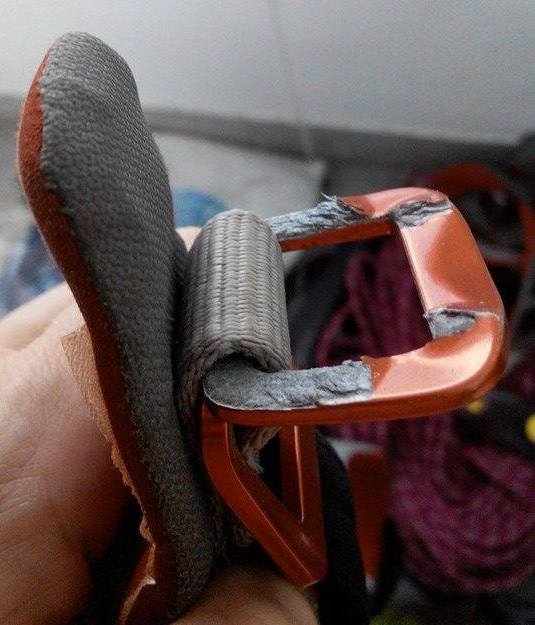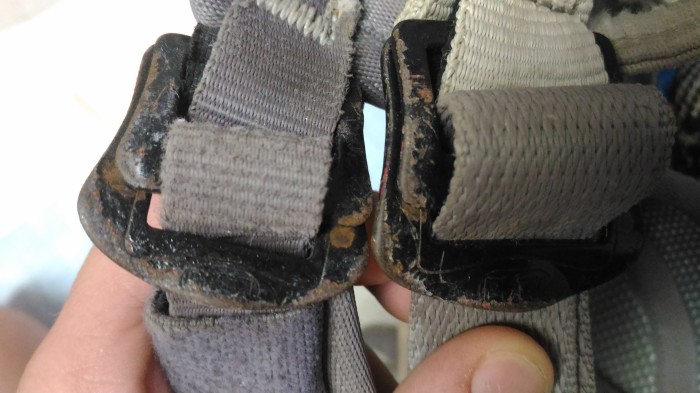
Harness – is part of the lifeline in a climbing system, along with the rope and anchors. If a harness fails, doesn’t matter how strong your bolts, rope or arms are, you are likely to meet a catastrophic end.
It is a piece of gear that we seldom check and most climbers in Singapore often ask me when they should retire their harness. I also have climbers coming to Taiwan for a few days of climbing with old crusty harness they had received when they started climbing 10-15 years ago. Needless to say we gave them a free loaner and told them they should go shopping when they head back home.
The common question is should we retire harnesses by age? Are the tie-in points too worn? Do the buckles look rusty? The belay loop looks a little frayed, should I still be using it?
The answer to all these questions is simple. When in doubt, change it! A harness in Singapore can cost as little as SGD88 and you get to test and try them in a store. I highly recommend everyone to wear a harness, hang on a rope, drink a cup of coffee before committing to buying one. After all when you are 5m above the last bolt, you do not want to think if your harness is going to hold that fall right?
We are going to talk about some common wear and tear to look out for:
Buckles
In our region, with high humidity and proximity to the ocean, it is a perfect formula for buckles (which are made from various types of metal) to corrode easily. Many harness makers just do not take this into account for some reason. The common climbing areas that a regular Singaporean climber visits includes some of the most corrosive sea cliffs in Asia, Tonsai/Railay – Thailand and Long Dong, Taiwan. Here are some examples of badly corroded buckles:





In my opinion, the buckle of the harness is the key mechanism to tighten and hold the user in place. It is one of the critical points of failure and should be paid extra attention to. If you see cracks, rust or worn out buckles, it might be a good idea to start shopping and retire that harness.
Tie-in points
As the name implies, it is the point where the rope goes into when the climber ties into the sharp end. A typical wear point would be the bottom loop which is the spot connecting to the leg loops. Somehow over the years and retiring many harnesses from my closet, I realise this is the most common wear and tear point. Repeated falls and hanging on the rope may have caused this. But how does a worn-out tie-in point looks like?



Belay Loops
Usually belay loops are plenty strong. So strong that Black Diamond did a QC Lab test, and it stated that a 50% cut belay loop can still hold in excess of 1700kg?! So why would people be worried about their belay loop? For me I’m most worried when people turn up with home made ‘backup’ belay loops as shown below.


Well that being said in 2006 Oct, the climbing world lost one of its most established climber during his time, Todd Skinner. It was a well-talked about accident that many still mention these days. The story being his belay loop broke when he clipped into his Grigri to rap off the Leaning Tower in Yosemite. The first time the red flag was raised at the base of the climb, when his partner mentioned to him about how worn his belay loop looked. During the 5 days on the wall, his daisy chains were also permanently girth-hitched to his belay loop which could have further abused the already worn-out belay loop.
With all these mentioned, it could be prevented if we check out gears regular and retire old gears that we have doubt in. Also permanently girth-hitching slings to your belay loop will cause accelerated wear and tear to hot spots of the belay loop.
Environment and storage
Avoid corrosive enviroment like storing your favourite harness in the garage cupboard that holds your engine oil, car solvents and what not. Dry, cool and clean environment are the best for webbings which makes your car trunk one of the not so ideal place for storage too.

So here you have it, the basic guide to retiring your harness. There are plenty of articles about which harness works the best so I’m not going into that. My personal all-round go-to harness is the Arcteryx AR-395 which really suits my diverse usage and features packability for my travel lifestyle. I also have a blue collar harness for day-to-day abuse which stands up to the corrosive environment from climbing in the sea cliffs of Taiwan, Singing Rock Onyx. This harness is well-priced and features a stainless steel buckle which is slowly becoming a staple for some harness manufacturers.
Which harness do you like? Do you have some worn out harness pictures to share too? Post under my comment page and share it with other readers!